Press Living Spaces, Exhibition Highlight in Mousse Magazine
Tolia Astakhishvili, Beatrice Bonino, Patricia L. Boyd, Florence Carr, Wisrah C. V. da R. Celestino, Tony Cokes, Margaret Honda, Cezary PoniatowskiLiving Spaces
1 December 2023 — 27 January 2024
Living Spaces
Living Spaces
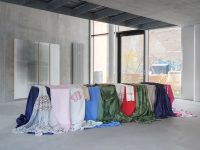
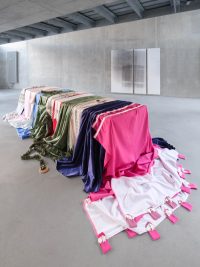

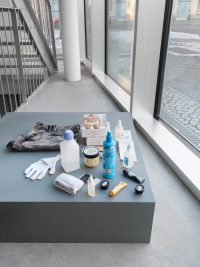
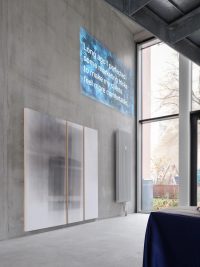
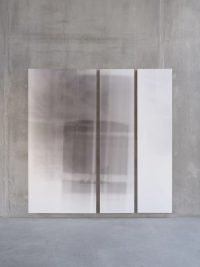
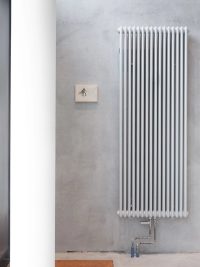
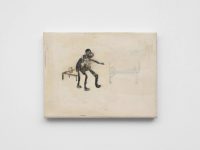
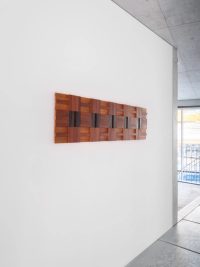
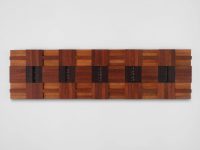

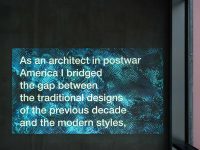

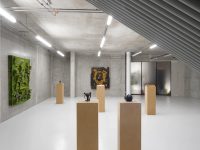
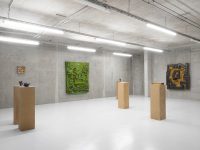
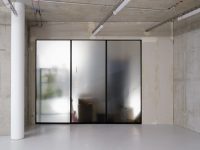
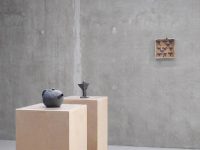

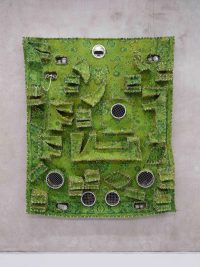
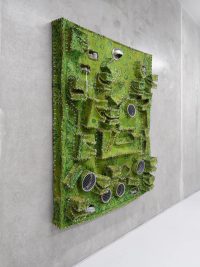
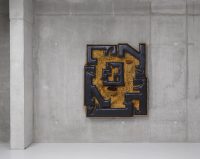
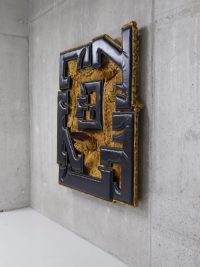
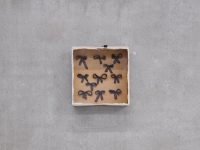
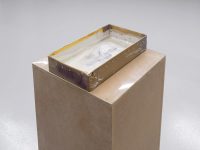
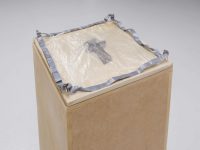
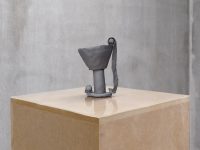
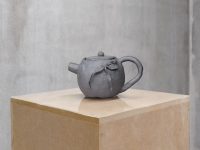
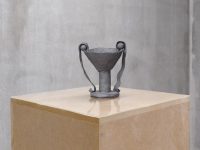
Living Spaces Tolia Astakhishvili, Beatrice Bonino, Patricia L. Boyd, Florence Carr, Wisrah C. V. da R. Celestino, Tony Cokes, Margaret Honda & Cezary Poniatowski Opening 1 December, 6 — 9pm 2 December 2023 — 27 January 2024 Living Spaces brings together eight artists whose work engages varying aspects—material and conceptual, lived and imagined—of domestic environments. In a range of registers, the show reflects upon how we shape, and are shaped by, the spaces we inhabit. How the pulse of life animates material environments, as if rubbing off by friction or symbiosis. Found materials—in the form of discarded floorboards, old carpets, borrowed curtains, cardboard boxes, the text of an architect’s biography, the floorplan of a childhood home, or the way light enters a bedroom window—are a common thread throughout the exhibition, as these are artists attentive to the composition, connotations and internal logic of their surroundings. Blurring the boundary between art and life, such practices insist upon art as a mode of paying attention. The constellation of works, including a number of new installations conceived for the exhibition, becomes something like a fragmented or fractured domestic scene, abstracted as if through a cracked mirror. As such, Living Spaces proposes an intrinsic value in shifts in perspective, while offering an expanded meditation on the old quip, if these walls could talk. Tolia Astakhishvili’s (*1974, Tbilisi, Georgia) practice is deeply invested in how space is constituted and interacts with lived realities. Employing structural interventions, found materials, and delicate drawings, she reorients existing architectural structures to draw out possible narratives and evoke imaginary histories. Astakhishvili’s work often implies a domestic space, while destabilizing notions of “home” as something safe or stable. Instead it becomes a fragile space where traces of violence and conflict remain close at hand. For Living Spaces, Astakhishvili sealed off part of the gallery’s subterranean floor to construct a nook-like vitrine, where glimpses of greenery, fragments of furniture and other items are partially illuminated as abstracted shapes. The vitrine embodies a sense of division and inaccessibility, the vaguely discernible, outlined forms both intriguing and troubling. Just as the assortment of objects presses up against the plexiglas, so too is there the impression that the space itself pushes back on its surface or pushes away its motley domestic contents. The structure’s black frames also echo the gallery’s ground floor windows, emblematic of how Astakhishvili’s interventions subtly unsettle and reconfigure their surroundings. Beatrice Bonino’s (*1992, Turin) work often takes containers like a found box, a ceramic vessel, or in looser terms, domestic space, as a starting point for her subtle play with texture, conditions of visibility and material connotations. As she moves between accentuating and destabilizing the act of containing, she also probes what it means to fasten—what that looks or feels like. The bows, pins, and locks that recur in her untitled sculptures (all works 2023) stand as various modes of fastening something, as well as flourishes that evoke the significance of the ornamental in alternative histories of abstraction. There is an uncanny quality to Bonino’s reimaginings as she treads a line between tapping into something deeply familiar and insistently strange, furthered by the way she employs materials seemingly against themselves: pinning cellophane, tying bows with lead or more broadly in asking what happens if rearranged remnants of vaguely banal household aesthetics are placed on a pedestal. The Paris-based artist holds a PhD in Sanskrit, and while her academic experience is distinct from her most recent sculptural practice, nearly fifteen years of studying ancient languages seems to imbue her work with a sense of piecing together forgotten modes of communication. Patricia L. Boyd’s (*1980, London) work probes the interdependence between the internal and external, often by enacting inversions or displaying negative space. Boyd pays attention to relationships between the interior and exterior of buildings and bodies, but also of institutions, in the broadest sense of the term. With both precision and an openness to chance, Boyd changes and expands the parameters of institutional critique by bringing an embodied, and often psychoanalytic approach to her work. While Boyd moves between sculpture, photography, writing, and video, photograms hold a particular place within her practice, and she has experimented with forms of staging this cameraless photography since 2015. For “Minutes, hours, or days,” 2021, large sheets of silver gelatin paper were exposed to ambient, nocturnal light—car headlights, the moon, illuminated neighboring apartments—from outside her fourth-floor apartment windows. The trees outside and the window frames are registered indistinctly, as the sheet of paper captures incomplete fragments of their forms. The series was conceived for an exhibition at the Kunstverein Munich, and Minutes, hours, or days II and V are exhibited again as part of Living Spaces. In both works, the photographic impression of the windows appears with a glitch-like stutter, an internal delay, caused by moving light from car headlights. Evocative of a kind of ghost photography, these photograms convey how present absence can be. Operating as both a surface and a threshold, both literally and symbolically, Boyd’s windows offer a mode of engaging how psychological and institutional spaces interact with and inflect one another. Florence Carr (*1997, Rutland, UK) repurposes parquet flooring in her woven assemblages. Carr tunes into the memories embedded in her materials, imagining what might have been imprinted upon these floorboards over decades of use. Sourcing her materials in classified ads that have taken her across London, where she lives and works, is part of a research process that informs the imagined narratives she transmutes in her abstract compositions. Carr’s delicate reliefs engage the role of nostalgia both in cultural production, as she both accentuates and questions the aura of her materials. Weaving traditions are also a significant point of reference for Carr, as she aligns her gridded compositions with needlepoint and pattern books—a world of grids that predates modernist claims on its organizing principles. She embeds most of her works with Jacquard ribbons manufactured in a factory in Wuppertal, recontextualizing the floral patterns of home decorating. Disteln (2023), a new work conceived for the mezzanine in Living Spaces, takes its title from the name of another ribbon, as Carr often mismatches the ribbons’ names with the ones used in her works, playfully alluding to the idea of weaving a story. Wisrah C. V. da R. Celestino’s (*Buritizeiro, 1989) practice engages the tradition of institutional critique, linguistic structures, and objecthood to address the enduring structures of the transatlantic colonial project. Often working with scores that operate somewhere between instructions for and descriptions of a work, C. V. da R. Celestino imbues theoretical questions of possession, property, and belongings with their own personal experience. In Living Spaces, they present the first incarnation of two new scores conceived for the exhibition: Privacy, A set of curtains loaned from the artist's family members and Left, A set of objects left in the artist's house by someone else. Both matter of fact and poetic, these scores are emblematic of the artist’s interest in the transactions by which relationships are mediated—ranging from the relationship between family members, to the Global North and South, to the artist and the gallery. By conceiving of an agreement as unusual as borrowing family members’ curtains—which the artist’s mother collected from relatives and shipped to Germany from Brazil—and presenting it in its kaleidoscopic vibrancy, C. V. da R. Celestino draws attention to the unarticulated social contracts that structure daily life. The thresholds between private and public space also come to the fore, as the artist considers the stakes of exhibiting or putting something on display, which is of course the implied contract between the artist and the gallery in an exhibition context. Video artist Tony Cokes (*1956, Richmond, Virginia) strives for thinking and feeling at once in text-based videos typically set against dance music, a form he has been developing since the 1980s. Often engaging power dynamics and popular culture, Cokes has recently become increasingly concerned with architecture and spatial politics, addressing Le Corbusier’s Carpenter Center at Harvard, London’s Piccadilly Circus and in The Will and the Way, Fragment 1 (2019), the life and work of Los Angeles-based architect Paul Revere Williams (1894-1980). The first African American member of the American Institute of Architects, Williams built over 2,500 notable buildings, including dozens of celebrities’ residences and numerous iconic hotel structures across Southern California. Stringing together direct quotations excerpted from Williams’s biography, Cokes constructs a document of the late architect’s legacy and homes in on Williams’s relationship to the spaces he built as something inextricable from race and inequality. The video becomes a poignant reflection upon what kind of space one can occupy, or not. Attentive to Williams’s entanglement with the aspirations and failures of modernism in its mid-century prime, Cokes conveys his ongoing interest in disturbing the ideals of modernism both in his subject matter and by employing modernist devices in deviant ways. Where modernist doctrine demands a rigorous distinction between formal questions and individual experience, Cokes advocates for the potential for new forms of meaning in overlaying various modes, such as narrative, documentary and structuralist filmmaking, for instance. Or in the unexpected juxtaposition of Williams’s written words and a soundtrack of Radiohead remixes that reverberate from the gallery’s mezzanine in Living Spaces. Since the late 1980s, Los Angeles-based artist Margaret Honda (*1961, San Diego) has developed a sculptural practice in which the historicity of objects, autobiography and process function as working materials. The basic premise of rearranging things—scale, concepts, functions—and a reconsideration of production methods and their protocols undergirds all her work regardless of the medium she deploys. Sculpture, film and drawing are media through which she examines the material basis of her output and interrogates the processes by which objects are made, presented and seen. In Living Spaces, Honda exhibits seven of her eight Make Ready Living Room (2012) silkscreen prints for the first time. These prints were initially employed as makereadys, or sheets of paper used by a printer to check for alignment of plates or screens, test for color, and adjust any aspects of production necessary to prepare for a print run, for the print edition 4366 Ohio Street Living Room (2012), part of the ongoing work 4366 Ohio Street (2004–). Struck by the makeready’s incomprehensible presentation of space, Honda reconceived of these preparatory tools as autonomous works in their own right. 4366 Ohio Street is a full-scale reconstruction in paper of Honda’s childhood home in Southern California, which her parents rented for nearly thirty years. Its format is a series of print editions, each a reproduction of one room published as an insert or as pages within a publication. An edition is developed by dividing a room’s surface area—walls, ceiling, floor—into a grid with hundreds, or even thousands, of cells of equal size. The dimensions and total number of the cells are calculated so that each copy of the publication contains a single cell. An edition consists of individual prints of these cells at 1:1 scale, accompanied by a diagram of the room in which every cell has been assigned a different number. If all the prints for a room were assembled according to the diagram they would form a sculpture of that room, but this is unlikely to happen. The closer Honda gets to finishing the house, the more fragmented it becomes, both structurally and geographically. The work, which someday will be complete in principle, can never in fact be completed—that is, assembled into a whole. Cezary Poniatowski (*1987, Olsztyn, Poland) makes wall reliefs from old carpets, pleather, and foam used to insulate homes in the former Eastern Bloc, including in Warsaw, where he lives and works. The surface is paramount in Poniatowski’s work as he riffs on modernist picture planes in a lineage of the likes of Lee Bontecou and Steven Parrino, while also approaching his materials as skin-like exteriors that might convey something of the unconscious of the rooms off of which they were peeled. Nodding to histories of surveillance, as well as voyeuristic imaginings, Poniatowski’s work also wonders what these walls might have seen or heard. By embedding binoculars, headphones, and other sensory objects into the bulges and cavities of his abstract compositions, he suggests that like the domestic spaces they loosely refer to, these works are also interlocutors actively perceiving and interacting with their surroundings. While playfully reconfiguring questions of who is viewing who, Poniatowski’s work has a dark edge, inviting in a sense of something haunted or repressed bulging to the surface. Formally, the sculptural reliefs associated with Socialist Realism are one such specter, as Poniatowski abstracts the monumentalizing effect, as well as the squat and weighty quality, of that state-sanctioned movement. In two new untitled works for Living Spaces—two of his largest works to date—Poniatowski continues his synesthetic exploration of carpet configurations in an eerie green textile populated with compartments fastened with the like of lead seals and vent ties in one work, while leaning into a juxtaposition in texture and material associations of pleather and carpet in the other.



























